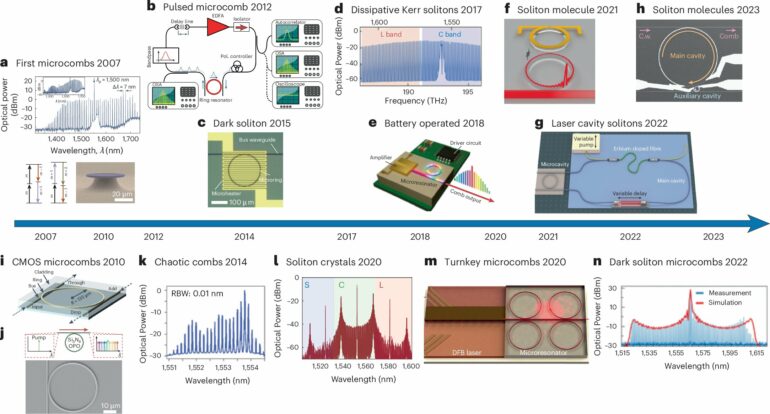A paper published by Swinburne University of Technology shows how a kind of “optical ruler,” or frequency comb, can greatly increase bandwidth in today’s data-saturated world. Integrated optical frequency comb sources, or microcombs, have driven major advances in spectroscopy, metrology and more. Their potential in data transmission is especially promising, exceeding speeds of one petabit per second—10 million times faster than a 100Mbit/s NBN connection.
Distinguished Professor David Moss, director of the Optical Sciences Center at Swinburne University of Technology, and deputy director of the Australian Research Council Center of Excellence, the Center for Optical Microcombs for Breakthrough Science (COMBS), is an author of the paper titled “Optical microcombs for ultrahigh-bandwidth communications” in Nature Photonics.
A laboratory-based optical frequency comb earned the 2005 Nobel Prize in physics. The technology has enabled breakthroughs in microwave photonics, frequency synthesis, optical ranging, quantum sources, and more, but one of its greatest successes has been in optical communications.
“The world’s optical fiber communications network forms the backbone of the global internet. Worldwide traffic is hundreds of terabits of data every second and growing exponentially at over 25% per annum,” says Professor Moss.
While optics has greatly underpinned this, the exponentially increasing demand for data—being driven in large part by data centers and artificial intelligence—has created huge bottlenecks that will need radical technological innovations to overcome. Integrated microcombs can generate hundreds of wavelengths coherently on a single chip and have now achieved levels of performance, reliability, stability and coherence, allowing them to serve as integrated sources for ultra-high capacity data transmission.
This paper reviews this progress and covers the state of this field, discussing promising new types of microcombs, new technologies such as space division multiplexing, and in which markets microcombs may have the biggest initial impact.
“These devices have already enabled research demonstrations of communications at unprecedentedly ultra-high bandwidths and with greatly reduced energy consumption in an ultra-small integrated footprint. They could very well be a game-changer in meeting growing bandwidth demands—particularly for data centers—and reducing energy consumption to perform well beyond existing technology,” says Professor Moss.
More information:
Bill Corcoran et al, Optical microcombs for ultrahigh-bandwidth communications, Nature Photonics (2025). DOI: 10.1038/s41566-025-01662-9
Provided by
Swinburne University of Technology
Citation:
Microcombs could be key in meeting bandwidth demands for artificial intelligence and data centers (2025, May 8)



